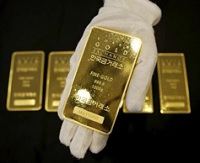March Payrolls Report And Gold

 The U.S. economy added 215,000 jobs in March. What does this imply for the Fed policy and the gold market?
The U.S. economy added 215,000 jobs in March. What does this imply for the Fed policy and the gold market?
Pace of Hiring
Total nonfarm payroll employment rose by 215,000 in February, according to the U.S. Bureau of Labor Statistics. Therefore, the pace of hiring in the U.S. slowed down compared with 245,000 job gains in February (after revision). However, the recent job gains were slightly higher than the 210,000 expected, while the U.S. economy has been creating more than 200,000 jobs monthly since 2014. There were no significant revisions of past reports. Payrolls by industries show further significant gains for education and health services, retail trade, leisure and hospitality, and professional and business services. On the other hand, manufacturing, mining and transportation, and warehousing were down once again.
The steady pace of hiring should reassure the Fed that the economy is healthy and prompt it to raise interest rates in the nearest future (e.g. in June), but the report is not strong enough to reawaken talks of a rate hike in April, especially after Yellen’s dovish speech given last week at the Economic Club of New York.
Unemployment Rate and Labor Force
The unemployment rate, meanwhile, rose a tick to 5% from 4.9%, but it is the result of strength rather than weakness of the labor market. This is because more Americans joined the labor force to search for work. Therefore, the increase in the unemployment rate came not because of fewer people working, but because more people were looking for jobs. In consequence, the labor force participation rate, a measure of the active portion of an economy’s labor force (i.e. people who are either employed or actively looking for work), rose to 63 percent - the highest level since March 2014. As one can see in the chart below, the labor force participation rate has been increasing since last September.
Chart 1: The U.S. civilian labor force participation rate from 2011 to 2016.
Other Indicators
Other labor market indicators were little changed in March. The number of long-term unemployed and the number of persons employed part time for economic reasons were essentially unchanged. The average workweek for all employees on private nonfarm payrolls was also unchanged at 34.4 hours in March. On the other hand, worker pay rebounded after a small decline in the prior month. The average hourly earnings for all employees on private nonfarm payrolls increased 0.3 percent to $25.43, following a 0.1 percent decline in February. On an annual basis, the average hourly earnings rose by 2.3 percent, at the same pace as in February. The rebound in worker pay is what the Fed officials like best, since the revived wage growth would be a signal of the accelerated pace of inflation and thus, reassure them that the next interest rate hike is the appropriate move.
Conclusions
The key takeaway is that the March Nonfarm Payroll was strong, as the U.S. economy added more jobs than expected, the wages rebounded and the labor participant rate increased. The April hike is off the table (the report was not strong enough to warrant a Fed hike this month), but the odds for other months this year increased. U.S. interest rate futures suggest that traders are now betting the Fed will next raise rates in September (versus December) ahead of the report. In consequence, gold declined $20 to $1,210 after the report was released. The stoked speculation that the Fed could raise interest rates might be negative for the price of gold. Now, the main focus will be on the Fed’s upcoming meeting in April.
Disclaimer: Please note that the aim of the above analysis is to discuss the likely long-term impact of the featured phenomenon on the price of gold and this analysis does not indicate (nor does it aim to do so) whether gold is likely to move higher or lower in the short- or medium-term. In order to determine the latter, many additional factors need to be considered (i.e. sentiment, chart patterns, cycles, indicators, ratios, self-similar patterns and more) and we are taking them into account (and discussing the short- and medium-term outlook) in our trading alerts.



















